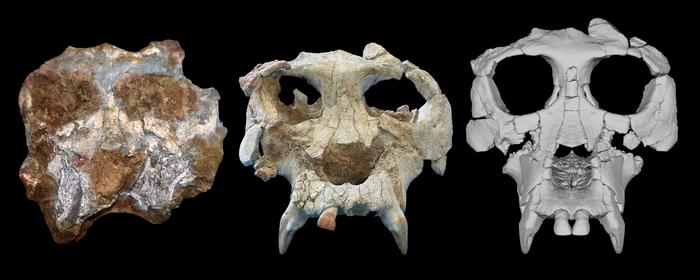A new study led by scientists at the American Museum of Natural History, Brooklyn College, and the Catalan Institute of Paleontology Miquel Crusafont has reconstructed the well-preserved but damaged skull of a great ape species that lived about 12 million years ago. The species, Pierolapithecus catalaunicus, may be crucial to understanding great ape and human evolution. The researchers describe their findings today in the journal Proceedings of the National Academy of Sciences.

Credit: © David Alba (left), Salvador Moyà-Solà (middle), Kelsey Pugh (right)
A new study led by scientists at the American Museum of Natural History, Brooklyn College, and the Catalan Institute of Paleontology Miquel Crusafont has reconstructed the well-preserved but damaged skull of a great ape species that lived about 12 million years ago. The species, Pierolapithecus catalaunicus, may be crucial to understanding great ape and human evolution. The researchers describe their findings today in the journal Proceedings of the National Academy of Sciences.
Pierolapithecus catalaunicus, a species from northeastern Spain first described in 2004, was one of a diverse group of now-extinct ape species that lived in Europe around 15 to 7 million years ago. The species is key to understanding the mosaic nature of hominid (great ape and human) evolution because it is known from a cranium and partial skeleton of the same individual—a rarity in the fossil record.
“Features of the skull and teeth are extremely important in resolving the evolutionary relationships of fossil species, and when we find this material in association with bones of the rest of the skeleton, it gives us the opportunity to not only accurately place the species on the hominid family tree, but also to learn more about the biology of the animal in terms of, for example, how it was moving around its environment,” said lead author Kelsey Pugh, a research associate in the Museum’s Division of Anthropology and a lecturer at Brooklyn College.
Previous work on Pierolapithecus suggests that an upright body plan preceded adaptations that allowed hominids to hang from tree branches and move among them. However, debate persists about the species’ evolutionary place, partly due to damage to the cranium.
“One of the persistent issues in studies of ape and human evolution is that the fossil record is fragmentary, and many specimens are incompletely preserved and distorted,” said co-author Ashley Hammond, associate curator and chair of the Museum’s Division of Anthropology. “This makes it difficult to reach a consensus on the evolutionary relationships of key fossil apes that are essential to understanding ape and human evolution.”
In an effort to bring clarity to these questions, the researchers used CT scans to virtually reconstruct the cranium of Pierolapithecus, compare it to other primate species, and model the evolution of key features of ape facial structure. They found that Pierolapithecus shares similarities in overall face shape and size with both fossilized and living great apes, but it also has distinct facial features not found in other Middle Miocene apes. The results are consistent with the idea that this species represents one of the earliest members of the great apes and human family.
“An interesting output of the evolutionary modeling in the study is that that the cranium of Pierolapithecus is closer in shape and size to the ancestor from which living great apes and humans evolved. On the other hand, gibbons and siamangs (the ‘lesser apes’) seem to be secondarily derived in relation to size reduction,” said co-author Sergio Almécija, a senior research scientist in the Museum’s Division of Anthropology.
Other authors on this study include Santiago Catalano, from the Fundación Miguel Lillo (Argentina); Miriam Pérez de los Ríos, from the Universidad Complutense de Madrid; Josep Fortuny, from the Catalan Institute of Paleontology Miquel Crusafont (ICP); Brian Shearer, from New York University; Alessandra Vecino Gazabón, from the American Museum of Natural History; Salvador Moyà-Solà, from the ICP and ICREA; and David Alba, from the ICP.
DOI: https://doi.org/10.1073/pnas.2218778120
ABOUT THE AMERICAN MUSEUM OF NATURAL HISTORY (AMNH)
The American Museum of Natural History, founded in 1869 with a dual mission of scientific research and science education, is one of the world’s preeminent scientific, educational, and cultural institutions. The Museum encompasses more than 40 permanent exhibition halls, galleries for temporary exhibitions, the Rose Center for Earth and Space including the Hayden Planetarium, and the Richard Gilder Center for Science, Education, and Innovation. The Museum’s scientists draw on a world-class permanent collection of more than 34 million specimens and artifacts, some of which are billions of years old, and on one of the largest natural history libraries in the world. Through its Richard Gilder Graduate School, the Museum offers two of the only free-standing, degree-granting programs of their kind at any museum in the U.S.: the Ph.D. program in Comparative Biology and the Master of Arts in Teaching (MAT) Earth Science residency program. Visit amnh.org for more information.
Journal
Proceedings of the National Academy of Sciences
DOI
10.1073/pnas.2218778120
Article Title
The reconstructed cranium of Pierolapithecus and the evolution of the great ape face




